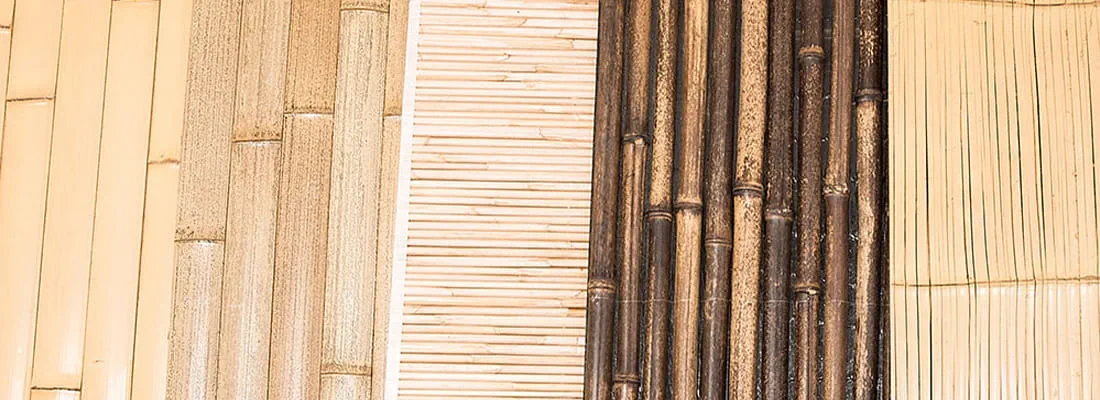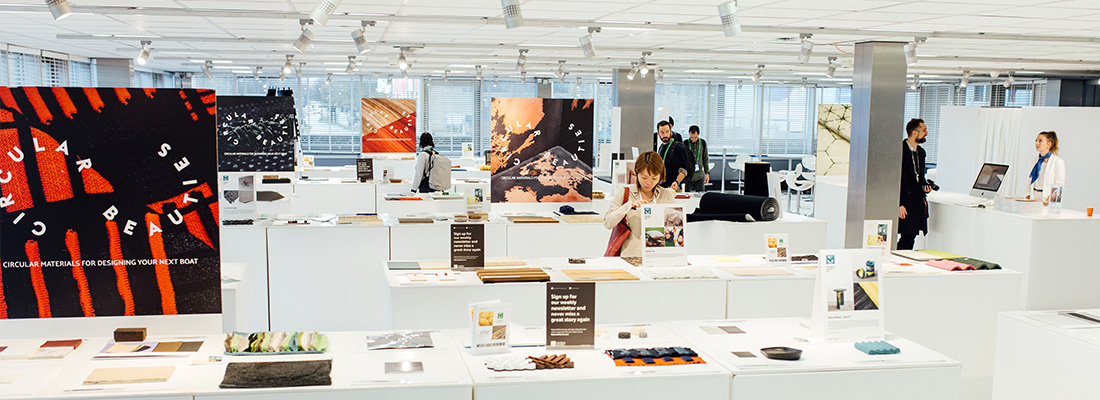A regular feature at METSTRADE which has become very popular in recent years, is the Material District display, featuring dozens of futuristic materials on show with full descriptive details.
Working as a leading match-making platform in the field of innovative materials, the Netherlands based Material District network cooperates globally with 150,000 contacts, continuously exploring new materials which can contribute to a more sustainable and higher quality society. Choosing ‘Circular Beauties’ as their theme last year, was an obvious reference to the importance of material selection in industrial activities, supporting the move towards the concept of the Circular Economy.
Founder and director of Material District, Els Zijlsta, an architect by profession, gave an interesting talk at the InnovationLab stage during the show, during which she shared with the audience some insights into how the development of bio / sustainable materials is providing opportunities for designers to move away from some of the traditional choices derived from non-renewable sources.
Els pointed out that the architectural world is making huge strides in the transition away from non-renewables, and that some of the materials they are using can be adopted in the leisure marine / boat building industry. As a background to the talk, she posed the question, ‘are we able to make yachts from bio based or totally recycled materials?’
Transition time is now
As a background to the talk it was mentioned that the world is currently going through three transitions, all of which have an influence on material selection in some way; the first one is about Climate Change and reducing CO2 emissions; the second is about the energy going into material production and end-of-life scenarios; and the third is related to public health with regard to the use and affects of hazardous / toxic materials. These three transitions are integrated with each other, and none of them can be looked at in isolation.
Els also showed graphs that demonstrate how the oil and gas reserves which have driven industrial production for most of the last century, now have a maximum of 200 years left before they are depleted. With global population growth bringing 200,000 more people per day onto the planet, the present rate of usage will simply not be sustainable for materials like plastic, composites, aluminium and concrete. The latter being the second most highly consumed material in the world after water, with plastics catching up fast! So, the transition to bio-based materials must be accelerated, as they have the capacity to grow at a rate that can keep up with their usage.
The Ladder of Circularity
With another graphic illustration, Els explained the main points to observe in the ‘Ladder of Circularity’ an important guideline for designing and manufacturing the products of the future.
1) Try to avoid new materials.
2) Try to repair / maintain.
3) Try to find a new purpose other than the original.
4) Try to reuse / refurbish.
5) If none of the above apply, try to up-cycle / remanufacture the material.
In the architecture world, recycling of previously redundant / wasted materials is already creating huge business opportunities, with ‘passporting’ of materials, and online market places being created for professional upcyclers to trade end-of-life materials into new usages. An example is: www.harvestmap.org
However, looking at the mineral cycles of concrete, plastic, aluminium etc, it is very evident that it’s not possible to reuse everything, so waste streams are unacceptably high and environmentally unsustainable. Cement is one of the most C02 polluting materials in the world; plastic is the most difficult to recycle, bauxite for aluminium cannot be continuously taken from the earth, and generally none of these will be able to meet future demand based on current usage trends.

Look to nature for inspiration
According to Els, the packaging, sports and defence industries are investing the most in bio / recycled materials that are lightweight, strong and sustainable. She says, ‘watch out for cork as a growth material of the future.’ It is highly replaceable, can be harvested very 7 years by removing the cork bark layer, and allowing the under growth to continue. It is fire resistant, anti-bacterial, very lightweight, it floats, and can be used on boats for things like decking and acoustic / vibration / thermal insulation. Bamboo, another fast growing and highly C02 absorbing plant, can be engineered into hard wearing, rot resistant cross laminated panels which can be used in boat construction.
And the development of bio based technology is advancing rapidly. Algae and yeast for instance, provide endless sources of natural raw material, and they are highly carbon absorbing. Els mentioned Mycelium in her talk, this is an interwoven network of thin threads, called hyphae or fungal threads, from which mushrooms and fungi are built. These microscopic wires ensure the absorption of nutrients from the environment and can fuse into a solid material. So, waste materials such as wood shavings can be added to the spores as they interconnect, and a tough lightweight construction panel material can be formed. (Similar to MDF panels for interior / furniture construction.) So, why not use it for boat interiors? After all, it comes from the sea!
She also mentioned Chitin, a very common glucose-based polysaccharide which forms the hard exoskeleton (shells) of insects and crustaceans like shrimp, crab and lobsters, which can be made into a bio-plastic material. Other natural or food waste substances which are being successfully turned into replacements for non-renewable materials are: cheese whey, agricultural waste (cow poo!), potato/corn starch, and even coffee grounds.
Veneers are commonly used in boat construction, many of them using expensive woods that are depleting C02 absorbing forests. ‘But there are other options’ says Els. Natural alternatives such as banana leafs, pineapple skins and bamboo can be used in combination with bio-resins. There is even a construction panel made from 85% natural peat, mixed with material from recycled plastic bottles.
More from Material District
Apart from exhibiting again at METSTRADE 2020, Material District also have pop-up shows during the year where the very latest material developments can be seen. And a really comprehensive exhibition with a full programme of presentations from material innovators is coming to Rotterdam next month, from 17th to 19th March at the Ahoy Stadium. For anyone who is in the Netherlands at that time, admission is free.
You can view the entire video recording of the presentation by Els Zijlstra here:

